Updated: 26-Jul-2024
SOLAR
(International)
In this chapter we will treat aircraft with engines that work by taking advantage of the energy coming from the Sun, which is converted through photoelectric cells to be used for electric motors that drive propellers.
-There are many projects in this sense and one of the latest, and certainly very interesting, is the one carried out by the Swiss Federal Institute for Technology, which applies to a large spanned motor glider (60 meters) with the wings covered with photoelectric cells above and below to take advantage of the reflective light.

“Solar motor glider”
-It can fly at high altitude to avoid clouds. It is estimated that the wings have 150 m2 of active surface.
-The maximum power of the two motors located at both ends of the horizontal tail stabilizer is 40 CV (30 Kw) and the average or continuous power on a sunny day is 12 CV.
-The speed varies between 50 and 120 km/hr. and the optimal altitude would be between 10 and 12 thousand meters. It is in the testing stage.
From Appendix 6: The propulsion system using solar energy through photoelectric cells and storage batteries continues to advance.
-In this year 2010 the Swiss plane of André Borchsberg has flown 26 hours including the night, marking a record.

“Moment of the historic flight”
-I receive more and more information about electric planes with solar panels from collaborators of this publication.
-From the MacCready with DuPont as sponsor to other less known ones like the UFM or the English Solar One, to the American NASA projects.
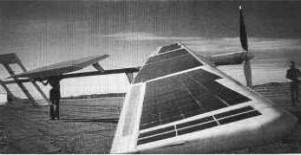
“MacCready's solar airplane”
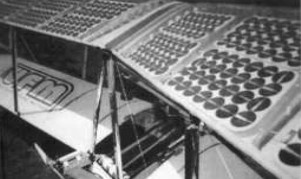
“The UFM”
-The solar cells in the form of wafers from the early days are clearly observed.
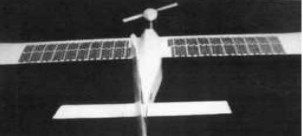
“The British solar plane with a permanent magnet engine”
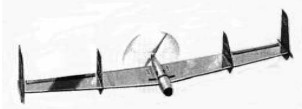

“Two NASA solar aircraft prototypes”
-Another way of using solar energy in space is to use parabolic screens that will heat pipes for generating steam to move a turbine and its generator, as we can see below.

“Diagram of a space solar energy system”
-The keys to the diagram are:
1, Steam turbine.
2, Shaft.
3. Storage battery.
4, Electric generator.
5, Solar radiation.
6, Steam generator.
7, Concave mirror.
8, Booster pump.
9, Condenser.
10, Solar radiation in outer space.
From Appendix 7: Making good use of solar energy. Examples continue to appear, such as the Solar Challenger case published in Flight magazine in 1981.
-Naturally, the surface of the extrados of the main wing and the horizontal stabilizer are used to place many photoelectric cells that operate an electric motor and a propeller. As we can see below.
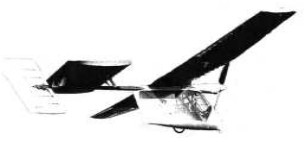
“The Solar Challenger in flight” (PiP)

“Solar Challenger triptych” (PiP)


